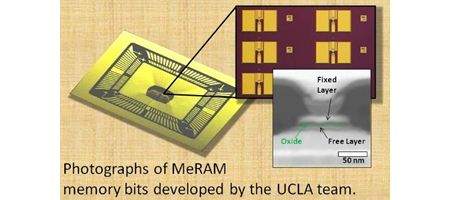By using electric voltage instead of electric current, UCLA researchers say they’ve made major improvements to the ultra-fast, high-capacity magnetoresistive random access memory, or MRAM.

Dubbed MeRAM, for magnetoelectric random access memory, the technology has great potential for future memory chips in devices such as smartphones and PCs, as well as for solid-state data storage.
MeRAM combines low energy with very high density, high-speed reading and writing times, and non-volatility – the flash-like ability to retain data when no power is applied.
Currently, magnetic memory is based on a technology called spin-transfer torque (STT), which uses the spin of elextrons, along with their charge. But this still requires a certain amount of power, and memory capacity is limited by how close to each other bits of data can be physically placed.
With MeRAM, though, the STT’s electric current is replaced with voltage – the difference in electrical potential – to write data into the memory. This eliminates the need to move large numbers of electrons through wires, making the system 10 to 1,000 times more energy-efficient. And, says the team, the memory can be more than five times as dense.
“The ability to switch nanoscale magnets using voltages is an exciting and fast-growing area of research in magnetism,” says Pedram Khalili, a research associate in electrical engineering.
“Once developed into a product, MeRAM’s advantage over competing technologies will not be limited to its lower power dissipation, but equally importantly, it may allow for extremely dense MRAM. This can open up new application areas where low cost and high capacity are the main constraints.”
The technology can also enable new instant-on electronic systems where memory is integrated with logic and computing, eliminating standby power and improving functionality.





